标题:美国SignaGen转染试剂--LipoD293™
Description
By utilizing our innovative and proprietary lipid conjugation technology, LipoD293™ (Ver. II) is specially designed and formulated by adding proprietary enhancers for transfecting HEK293 cells and other mammalian cells. As a 2nd generation liposome based DNA transfection reagent, LipoD293™ (Ver. II) offers extremely high transfection efficiencies for HEK293
related cells
as well as many mammalian cells with less cytotoxicity. LipoD293™ reagent (Ver. II), upgraded from its previous version with refined chemistry, is 3~4 times more efficient in gene delivery. LipoD293™ reagent (Ver. II), 1.0 ml, is sufficient for 300 to 600 transfections in 24 well plates or 150 to 300 transfections in 6 well plates.
Figure 1. A Cartoon Showing LipoD293™ (Ver. II) Enhanced Gene Delivery
Features
- Top choice for hard-to-transfect cells
- Exceptional high titers of virus production
- Equally good for very long DNAs (up to 180 kb)
- Equally good for suspension 293 cells (e.g., 293F, 293H, etc)
- High levels of recombinant protein production
- Presence of serum and antibiotics enhances efficiency on 293 cells
- Exceptional efficiency for both single DNA transfection and multi DNAs co-transfection
- Very affordable
Storage Condition
Store at 4 °C. If stored properly, the product is stable for 12 months or longer.
Comparisons of Transfection Efficiency of LipoD293™ DNA In Vitro Transfection Reagent (Ver. II) with
Brand Name Products
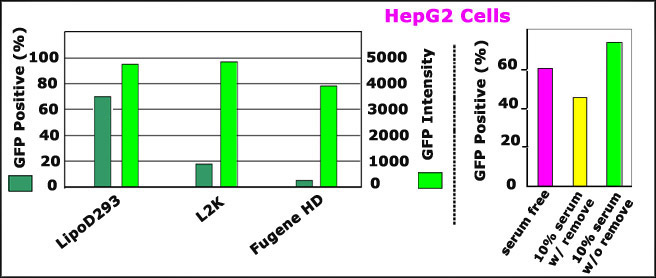
Comparison of transfection efficiency of LipoD293™ reagent (Ver. II) vs. lipofectamine 2000 (L2K) and Fugene HD on HepG2 cells.
Right Panel: Comparison of transfection efficiency of LipoD293 (Ver. II) with Lipofecatmine 2000 (L2K), and Fugene HD on HepG2 cells. GFP DNA (pEGFP-N3) was transfected with different transfection reagents per manufacturer's protocols to HepG2 cell (cultured on Collagen pretreated dishes). GFP positive cell (%) and fluorescence intensity were detected by passing through FACS 48 hours post transfection
Left Panel: presence of serum and antibiotics enhances LipoD293 (Ver. II) efficiency on HepG2 cells. HepG2 cell (grown on collagen treated dishes) was transfected with three different conditions-------serum and antibiotics free, presence of 10% serum and antibiotics followed by removal 5 hours post transfection and presence of 10% serum and antibiotics without removal 5 hours post transfection. 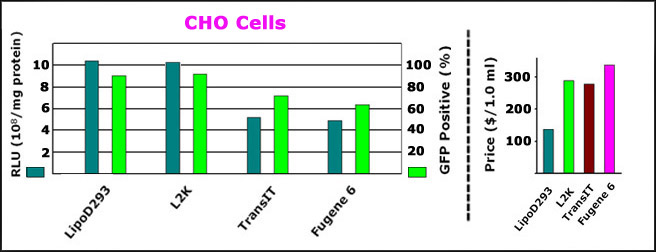
Comparison of transfection efficiency of LipoD293™ reagent (Ver. II) vs. lipofectamine 2000 (L2K), TransIT and Fugene 6 on CHO cells.
Right Panel: Comparison of transfection efficiency of LipoD293 (Ver. II) with Lipofecatmine 2000 (L2K), TransIT and Fugene 6 on CHO cells. DNAs encoding Renilla luciferase (phRL-CMV) and GFP (pEGFP-N3) were transfected with different DNA transfection reagent per manufacturer's protocols. Renilla luciferase activity and GFP fluorescence were detected with Renilla Assay System and a Nikon Eclipse fluorescent microcopy respectively 24 hours post transfection.
Left Panel: Comparison of price ($/1.0 ml vial) of LipoD293 versus those of Lipofecatmine 2000 (L2K), TransIT and Fugene 6. All the prices were collected from the manufacturers' websites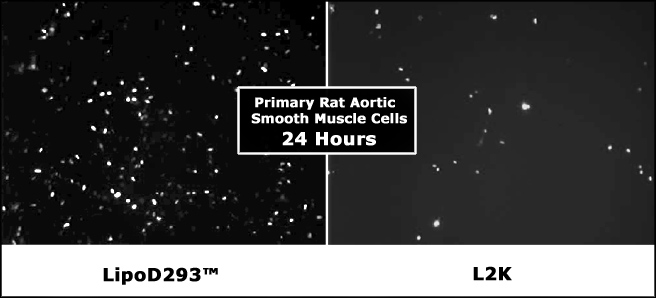
A comparison of transfection efficiency of LipoD293™ reagent with lipofectamine 2000 (L2K) on a hard-to-transfect cell, primary rat aortic smooth muscle cells. The rat aortic smooth muscle cells were prepared and transfected with pEGFP-N3 by LipoD293™ reagent (left panel) and Lipofecatmine 2000 (L2K, right panel) respectively per manufacturers' protocols. The transfection efficiency was evaluated by detecting GFP fluorescence with a Nikon Eclipse 2000 microscopy 24 hours post transfection. The above pictures were kindly provided by Dr. Nickolai Dulin of Section of Pulmonary and Critical Care, University of Chicago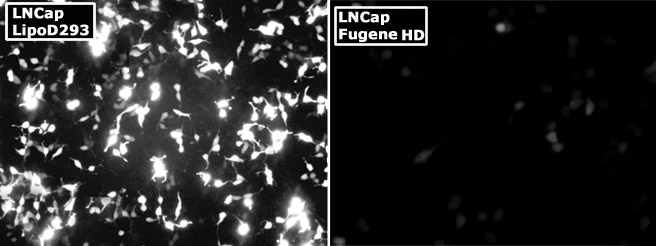
A comparison of transfection efficiency of LipoD293™ reagent with Fugene HD on hard-to-transfect cell, LNCap cells. The LNCap cells were grown as ATCC recommended procedures and co-transfected with pBabe-hygro-SSeCKs (1.5ug) and pEGFP-N3 (0.5ug) per well (6 well plate) LipoD293™ reagent (left panel) and Fugene HD (right panel) respectively per manufacturers' protocols. The transfection efficiency was evaluated by detecting GFP fluorescence with a Nikon Eclipse 2000 microscopy 24 hours post transfection. The above pictures were kindly provided by Dr. Lyn Gao of Roswell Park Cancer Institute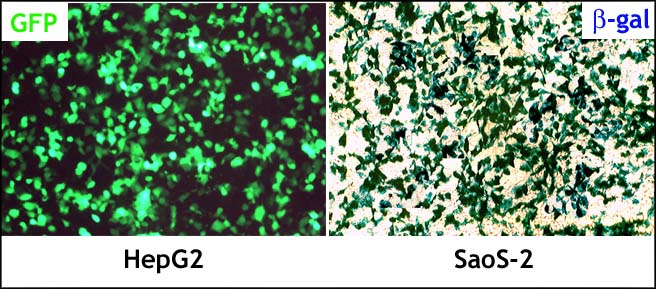
Two examples showing exceptional efficiency of LipoD293™ reagent on hard-to-transfect cells like HepG2 and SaoS-2 cells. HepG2 and SaoS-2 cells in 95% confluency were transfected with pEGFP-N3 and pSV-β-galactosidase DNAs respectively in presence of serum/antibiotics. The efficiency was checked 48 hours post transfection by Zeiss 510 Confocal Microscopy and β-galactosidase staining kit respectively.

HEK293 cells transfected with pEGFP-C1 plasmid using LipoD293™ In Vitro DNA Transfection Reagent (Ver. II) (upper panel) and the most popular brand product 293fectin™ of Invitrogen (lower panel). The cells were visualized by Nikon Eclipse Fluorescence microscope with DIC phase imaging (left panel) and FITC imaging (right panel) 24 hours post-transfection

A comparison of LipoD293™ (Ver. II) and Lipofecatmine LTX (LTX) on generation of Lentivirus (LV). Three cDNAs were co-transfected with LipoD293™ (Ver. II) and Lipofectamine LTX (LTX) into 293FT cells. A GFP vector, pHR-SIN-cppt-CMVEWP, was used to determine titer of LV. 1x105 293F cells per well was plated in to a 24 well plate followed by addition of different of amounts of the vector supernatant, 1 microliter (upper panel) and 10 microliters (lower panel) respectively. 5 days later, the cells was passed with FACS. The numbers at the upper right corner indicate the percentage of transduced cells. The titers of LV generated with LipoD293™ and L2K were quantified to be 8x106 and 3x106 tu/ml respectively
Technical Information & Datasheet
- LipoD293™ (Ver. II) Reagent General Protocol & Data Sheet
![]()
- LipoD293™ (Ver. II) Reagent for Lentivirus Production
![]()


A comparison of LipoD293™ (Ver. II) and Lipofecatmine LTX (LTX) on generation of Lentivirus (LV). Three cDNAs were co-transfected with LipoD293™ (Ver. II) and Lipofectamine LTX (LTX) into 293FT cells. A GFP vector, pHR-SIN-cppt-CMVEWP, was used to determine titer of LV. 1x105 293F cells per well was plated in to a 24 well plate followed by addition of different of amounts of the vector supernatant, 1 microliter (upper panel) and 10 microliters (lower panel) respectively. 5 days later, the cells was passed with FACS. The numbers at the upper right corner indicate the percentage of transduced cells. The titers of LV generated with LipoD293™ and L2K were quantified to be 8x106 and 3x106 tu/ml respectively
Technical Information & Datasheet
- LipoD293™ (Ver. II) Reagent General Protocol & Data Sheet
![]()
- LipoD293™ (Ver. II) Reagent for Lentivirus Production
![]()
中药对照品
15-羟基脱氢松香酸 15-hydroxydehydroabietic acid >98.5%
22-甲基-原薯蓣皂苷 22-meth-protodioscin
22-甲基-原纤细薯蓣皂苷 22-meth-protogracillin
22-甲基-原Pa 22-meth-protoPa
22-甲基-原Pb 22-meth-protoPb
25(R)滇黄精皂苷 G (25R) Kingianoside G
25R-dracaenoside F >98.5%
Esculeoside A >98.5%
R-methyophiopogonanone A和R-methyophiopogonanone B的混合物
Pennogenin-β-D-glucopyranosyl-(1→3)-[α-L-rhamnopyranosyl-(1→2)]-β-D-glucopyranoside
trans-2, 3, 5, 4'- tetrahydroxystilbene-2-O-β-D-glucopyranoside ≥99%
α-香附酮 α-cyperone ≥98%
白果内酯 Bilobalide >98.5%
白藜芦醇 Resveratrol ≥98%
白鲜碱 Dictamine ≥98%
补骨脂素 Psoralen ≥98%
梣酮 Fraxinellone ≥98%
茶黄素 theaflavin,TF ≥98%
茶黄素-3,3’-双没食子酸酯 theaflavin-3,3’-O-digallate, TFDG ≥98%
茶黄素-3’-单没食子酸酯 theaflavin-3’-O-monogallate, TF-3’-MG ≥98%
茶黄素-3-单没食子酸酯 theaflavin-3-O-monogallate, TF-3-MG ≥98%
橙皮苷 Hesperidin ≥98%
川陈皮素 Nobiletin ≥98%
慈溪麦冬皂苷A Ophiopojaponin C
丹参酮Ⅰ TanshinoneⅠ ≥98%
丹参酮ⅡA Tanshinone IIA ≥98%
单葡糖醛酸甘草次酸 GAMA >98.5%
滇黄精皂苷 C kingianoside C
丁香酚 Eugenol ≥98%
二氢丹参酮 Dihydrotanshinone ≥98%
二氢辣椒碱 Dihydrocapsaicin ≥98%
番茄碱 Tomatine
甘草次酸 GA >98.5%
甘草酸 GL >98.5%
葛根素 Puerarin ≥98%
哈尔明碱 Harmaline ≥98%
和厚朴酚 Honokiol ≥98%
红景天苷 salidroside >98.5%
厚朴酚 Magnolol ≥98%
胡椒碱 Piperine ≥98%
槲皮素 Quercetin >98.5%
黄柏酮 Obacunone ≥98%
黄芩苷 Baicalin ≥98%
甲基莲子心碱 Neferine ≥98%
剑麻拉皂苷C Sisalasponin C ≥99%
剑麻皂苷A Sisalasponin A ≥99%
降二氢辣椒碱 Nordidydrocapsaicin ≥98%
京尼平苷 Geniposide ≥98%
菊苣酸 Cichoric acid ≥98%
橘皮素 Tangeretin ≥98%
坎塔拉皂苷 1 Cantalasaponin 1 >98.5%
辣椒碱 Capsaicinoid ≥98%
酪醇 tyrosol >98.5%
雷公藤红素 Tripterine ≥98%
芦丁(芸香苷) Rutin ≥98%
绿原酸 Chlorogenic acid ≥98%
骆驼蓬碱 Harmine ≥98%
落新妇苷 astilbin >98.5%
麦冬皂苷D >98.5%
麦冬皂苷MD-1 >98.5%
麦冬皂苷zt-18 >98.5%
蔓荆子黄素 Vitexicarpin ≥98%
芒柄花素 Formononetin ≥98%
芒果苷(知母宁) Mangiferin >98.5%
莽草酸 Shikimic ≥98%
没食子酸 Gallic acid ≥98%
蒙花苷 Buddleoside ≥98%
木犀草素 Luteolin ≥98%
柠檬苦素 Limonin ≥98%
牛蒡子苷 Acrctiin ≥98%
officinalisnin-Ⅰ officinalisnin-Ⅰ
Purpureagitosid Purpureagitosid
progenin II protoprogenin II
蒲黄新苷 typhaneoside >98.5%
齐墩果酸 Oleanolic acid ≥98%
芹菜素 Apigenin ≥98%
去甲络石苷元 nortrachelogenin >98.5%
人参皂苷 F2 G-F2 >98.5%
人参皂苷 CK G-CK >98.5%
人参皂苷 Rd G-Rd >98.5%
人参皂苷Rb1 panaxsaponin Rb1 >98.5%
人参皂苷Re panaxsaponin Re >90%
人参皂苷Rg1 panaxsaponin Rg1 >98.5%
萨尔萨皂苷元 Sarsasapogenin >98.5%
山奈酚 Kaempferol ≥98
蛇床子素 Osthole ≥98%
士的宁碱 Brucine ≥98%
薯蓣皂苷 dioscin >98.5%
薯蓣皂苷元 Diosgenin >99%
松果菊苷 Echinacoside ≥98%
甜菜碱 Betaine ≥98%
土茯苓苷 >98.5%
纤细薯蓣皂苷 Gracillin >95%
香草醛 Vanilin ≥98%
熊果酸 Ursolic acid ≥98%
延胡索乙素 Tetrahydropalmatine ≥98%
异补骨脂素 Isopsoralen ≥98%
异槲皮苷 Isoquercitrin ≥98%
异鼠李素232 O2新橙皮苷 Isorhamnetin-3-O-neohesperidoside >98.5%
淫羊藿苷 Icariin ≥98%
银松素甲基醚 5-hydroxy-3-methoxy-trans-stilbene >98.5%
银杏内酯 A Ginkgolides A >98.5%
银杏内酯 B Ginkgolides B >98.5%
银杏内酯 C Ginkgolide C >98.5%
隐丹参酮 Cryptotanshinone ≥98%
鹰觜豆芽素 A Biochanin A ≥98%
柚皮素 Naringenin ≥98%
原progenin II protoprogenin II >99%
原阿片碱 Protopine ≥98%
原薯蓣皂苷 Pro-dioscin >97%
原薯蓣皂苷Pb Pro-Pb (dichotomin) >80%
原伪薯蓣皂苷Pb Pseudoproto-Pb >99%
原纤细薯蓣皂苷 Protogralillin >95%
原皂苷 Pa Pro-Pa >99%
芝麻素 Sesamin ≥98%
知母皂苷A2 Timosaponin A2
知母皂甙AⅢ Timosaponin AIII >98.5%
知母皂甙B Timosaponin B >95%
知母皂苷BI Timosaponin B I
知母皂苷E1 Timosaponin E1
知母皂苷N Timosaponin N
知母皂苷Ⅰ Timosaponin I
重楼皂苷 B Pseudoproto-Pa Parisyunnanoside B >95%
重楼皂苷 H >85%
重楼皂苷 V progenin III >98.5%
重楼皂苷 VI Tb >98.5%
重楼皂苷 VII Tg >99%
重楼皂苷I Pa >95%
重楼皂苷II Pb >95%